In the last six years Resisting Hate have seen the social media landscape of far right and right wing extremism change dramatically. Right wing stars have risen and fallen, censorship has culled many others and the interest from mainstream media has shone a disinfecting beam of light into the sordid corners of the internet where haters and their hatred have long flourished.
For those not following extremism closely it may be hard to appreciate just how much the last six years have weakened the unity and growth of the far right or to understand why a reconnaissance of the scene from 2021 gives anti-haters and anti-fascists so much hope for a brighter future.
Back in 2016 the UK far right scene was primarily characterised by Tommy Robinson and Britain First. Robinson had over a million followers on key social media platforms Twitter and Facebook. He had access to PayPal for donations and to a whole network of people sharing his videos across You Tube. Britain First also had a massive Facebook presence totalling over a million followers.
The effect of these huge mainstream followings was to legitimise the far right. Robinson wasn’t a shadowy figure on an obscure platform, he was a household name. Sponsored Facebook posts (funded by gullible followers) made their way into millions of timelines and widened the exposure of Robinson’s Islamophobia to a huge audience.
Britain First manipulated a huge audience by use of ‘click bait’ – innocuous posts that they paid to boost to encourage people to like and follow their page. Both Robinson and Britain First bought followers across Twitter and Facebook, artificially inflating their numbers to try and establish credibility for their views.
For a long time it seemed that the revenue these high profile haters were bringing the social media platforms outweighed any moral conscience Zuckerberg (CEO Facebook) and Dorsey (CEO Twitter) felt from amplifying the voices of hate. But then, in late 2017 Twitter permanently banned the Britain First founders and for the first time it became apparent that there were lines even the capitalists at Silicon Valley were unwilling to let their users cross.
This knowledge galvanised Resisting Hate and many other groups like us who are dedicated to deplatforming extremists on social media. When we realised that Terms of Service could and would be enforced we organised ourselves and went after our list of targets with a vengeance.
In early 2018 Britain First lost their Facebook page. A few days later Tommy Robinson was permanently suspended from Twitter.
The decision to ban these two high profile haters had a number of follow on consequences.
Firstly it set a precedent for other firms to follow through with censorship. Starting with large companies like PayPal who blocked Robinson in 2018 but then followed by smaller companies like payment processing Stripe. The tide shifted from companies concerned being overly censorious would impact their image to being concerned that being seen to back racists like Robinson and Britain First would have a much greater negative impact .
The second key consequence was that the social media platforms started to amend and enforce their Terms of Service with a real emphasis on eradicating hate speech. Facebook amended its algorithms to detect and close down racism and Twitter added new options to report accounts based on prejudice against racism and faith.
These changes in the primary social media platforms meant that a lot of low profile hate accounts suddenly started to find themselves suspended. Certainly the Resisting Hate teams got very adept at looking up key words and reporting hundreds and hundreds of accounts using racial slurs.
Facebook and Twitter were no longer a safe option for people wanting to log on the internet and abuse their fellow human beings.
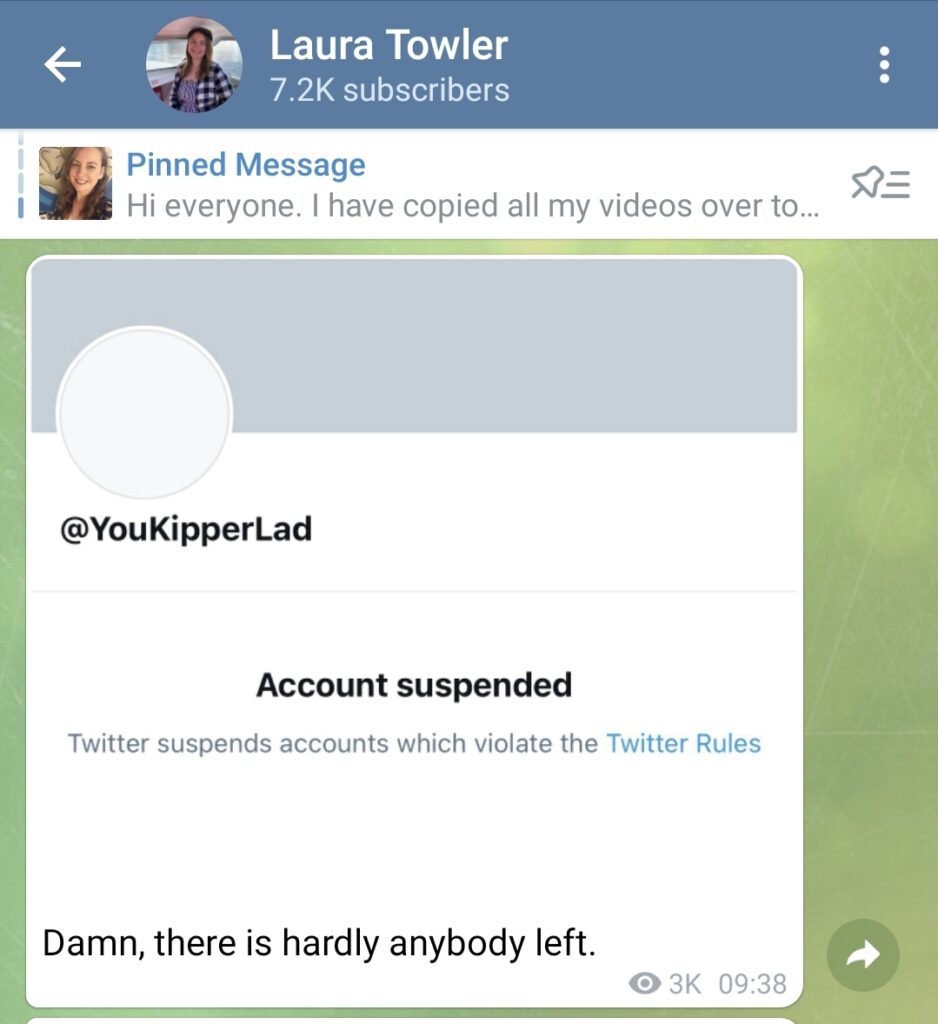
The first mass exodus from mainstream platforms was to the ‘free speech’ platform Gab.ai. It was not a free speech platform, it was a cesspit of racism, Islamophobia and Antisemitism. The founder, Andrew Torba, (who amazingly believes himself to be a Christian) promoted his site on a basis of no censorship and the right for all to speak freely.
The trouble with free speech though is give a hater an inch and they will just keep going. Eventually Gab had to bow to pressure and start censoring. We pushed hard on one filthsome individual who called himself ‘DieJewDie’ and got Gab to suspend him several times. So the platform was no longer a safe haven for extremism and that, combined with the fact there was no private messaging function on the site meant Gab was rejected as the next online home of the far right.
Ironically Gab was also unsuccessful based on the fact that it was too extreme as well as too censored. Many accounts migrated to Gab genuinely looking for free speech but ended up going back to Twitter as they preferred censorship to Holocaust Denial and threats of violence.
(Gab also experienced poor tech support and in early 2021 turned out to be an extremely unsafe platform too when it was hacked and all the member data downloaded. The private messaging feature which had eventually been added, albeit for a short period, was also downloaded leaving very well known users like Donald Trump exposed to anyone viewing the data. If Gab ever did have a future, it doesn’t now…)
By late 2019-2020 the leaders of the far right had been deplatformed from mainstream platforms and so had a lot of their followers. The next big migration was to Telegram.
Telegram has a very different functionality to Twitter and Facebook in terms of the fact it has no live feed. Telegram works a lot more like WhatsApp – but where you can join groups with strangers based on common interests as well as personal groups.
The problem with this, as far as the far right are concerned, is it is a lot harder to get a message in front of somebody who has not made a conscious decision to look at it. If a person doesn’t choose to join a group and look content they won’t see it. No more popping up in the feeds of those they term ‘normies’. This, combined with the fact that it is very hard to buy fake followers on Telegram, meant that the old million plus audiences were a thing of the past.
As of 5.3.2021 a glance at Telegram shows Tommy Robinson is currently sitting on 86k followers, 8.6% of the following he once had.

Britain First are doing even worse on 29k followers, less than 3% of the following they used to have.
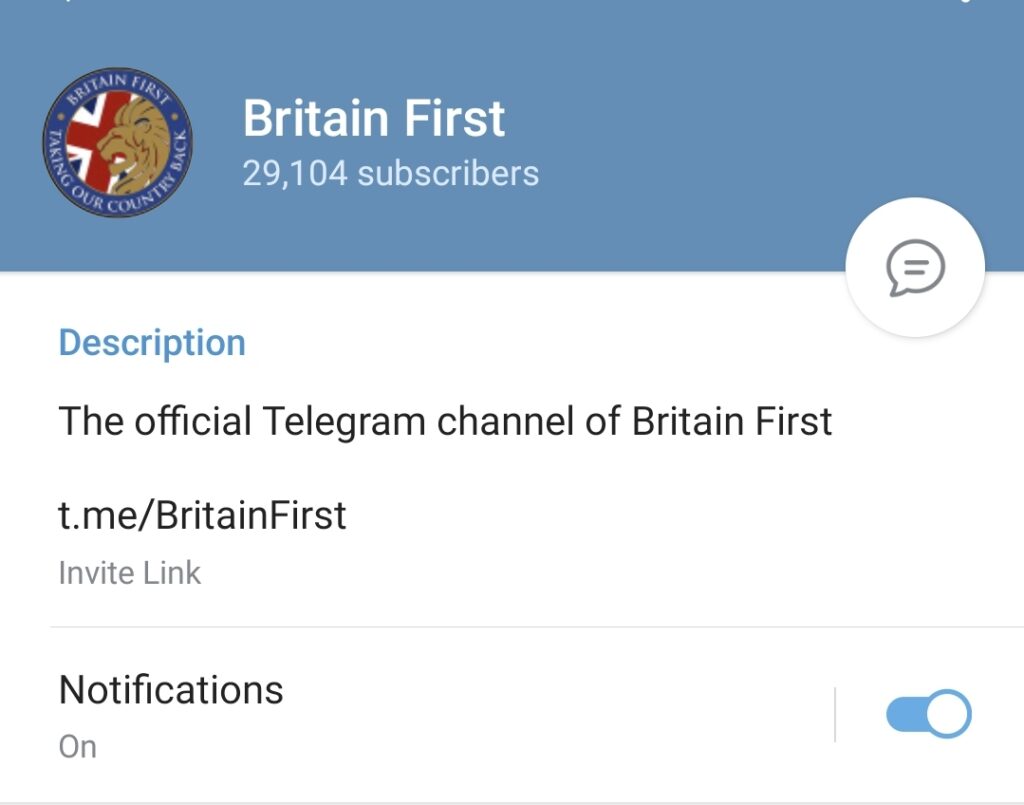
Telegram functionality doesn’t require all content to be viewed. So when a person opens a chat or channel the usual thing to do is press the button that takes you to the next post. This means that even where there are large follower numbers, many posts only get viewed by a fraction of people. To illustrate this, I looked at a post from Robinson that has been up for over a week but only 28% of the followers have seen it.
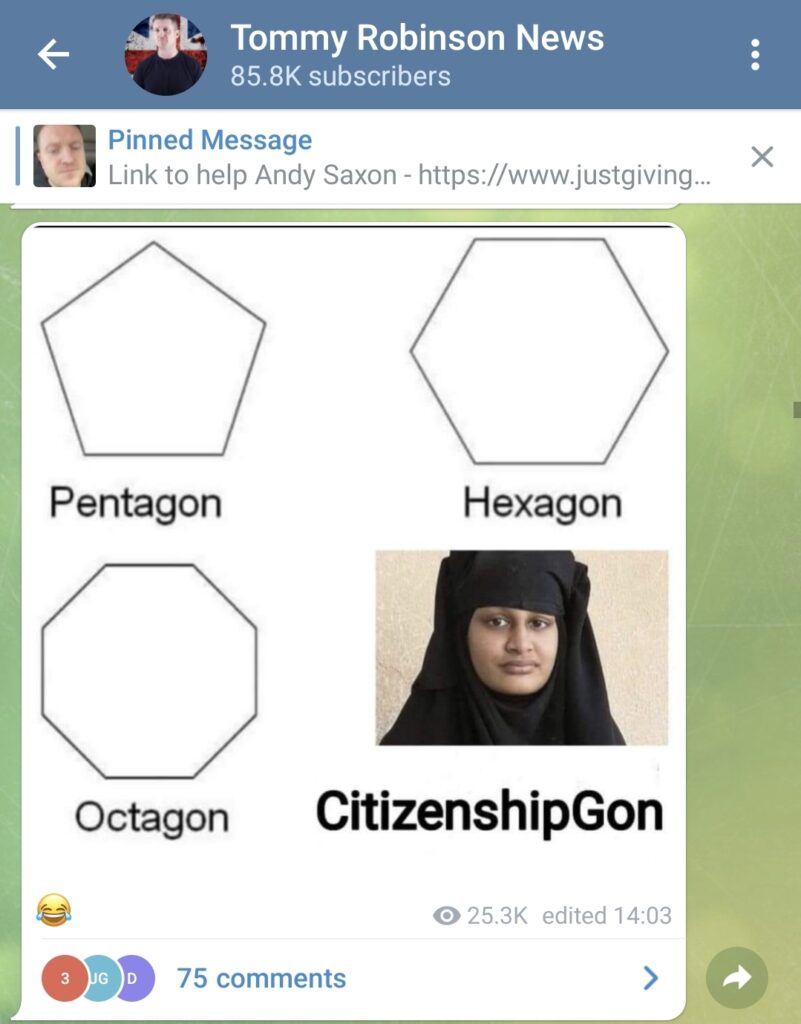
This poor exposure on Telegram results in low donations for those who seek to subsist from begging bowls filled by their followers.
With the main players in far right extremism relegated to small audiences, a lot of their star appeal was lost. This created a whole new era of far right leader wannabes who had seen the lifestyle Tommy Robison was leading at the expense of his followers and who wanted a piece of that pie for themselves. Numerous Telegram groups sprang up, most of which had fewer than 5k followers and very few indeed with over 10k members. Amusingly the same people were in pretty much all of them so Telegram simply became an echo chamber for the already indoctrinated.
It is interesting to note that Telegram has a large USA audience and this altered the dynamics of the hate we were seeing. Online hate in the UK had primarily (broadly) been focused around racism and Robison’s anti Muslim agenda but Telegram brought with it much more of an emphasis on Antisemitism which had not gained as much traction in the UK. (Neo Nazi groups like National Action existed in the UK but these were very small groups who hated Jews who were not looking to build a large social media following in the way the Islamophobic Britain First, For Britain and Tommy Robinson attempted).
Eventually the inevitable happened and the different far right factions began to bicker and war with one another. The primary schism was between those who supported Robinson and his anti Islam agenda and those who wanted to follow an anti-Semitic path. Neo Nazi and ex BNP frontman Mark Collett took advantage of the split and founded Neo Nazi group ‘Patriotic Alternative’ which siphoned off a scummy top layer of Robinson’s supporters.
But Telegram was an echo chamber with very little fresh blood coming in and there was only so much money to go around. Fighting over donations, warring over ideology, not to mention the drama and doxing in all the Telegram channels led to a weakened and under funded UK far right.
While the primary social media platforms were busy kicking off haters, You Tube was unusually slow to follow. Which suited the far right as most of their indoctrination is achieved through live streaming and making videos. Despite Google proclaiming loudly in 2017 that they planned to rigorously enforce You Tube’s anti hate policies very little was done. It wasn’t until 2019, nearly a year after his suspension from Facebook and Twitter that Robinson’s You Tube account was demonetised. Even calls from Parliament in April of that year failed to motivate Google to remove Robinson’s account entirely. Eventually You Tube bowed to public opinion in July 2019 and removed the pint sized hater from their site.
At this point the far right were frantically looking for new video platforms to broadcast on. The most popular choice emerged as Bitchute, an alternative media platform where it was believed there would be no censorship. Many of the content makers flocked to Bitchute and started to promote their channels on there heavily. However anti hate activists and the press openly called the site out for the lack of censorship and early 2021 it became apparent that Bitchute were not censorship free and would censor extreme content.
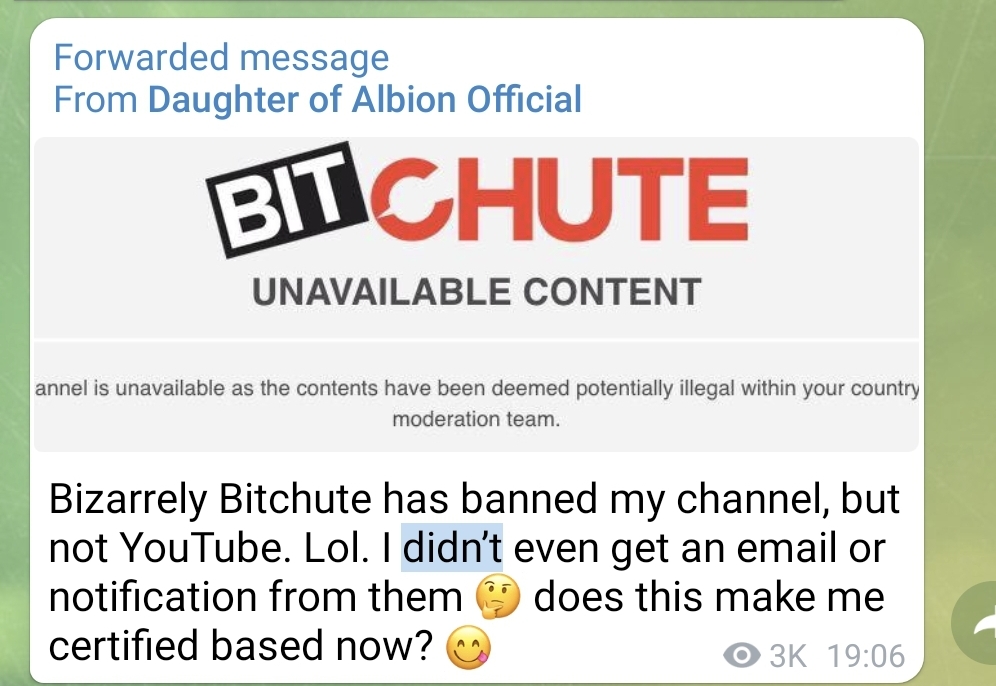
As the split in the far right widened and with no single platform emerging as a clear successor to Facebook and Twitter, the far right users started to dissipate over a choice of different platforms. Patriotic Alternative and the Nazis looked to utilise game streaming site DLive for their indoctrinating videos, Tommy Robinson’s supporters gravitated toward Russian Facebook alternative VK and other platforms like Minds and Parler took their share of new recruits with the promise of limited censorship. All factions retained a presence, albeit limited on Telegram.
This promised lack of censorship on alternative platforms proved to be little more than a myth. VK promptly banned Tommy Robinson from its site. DLive kicked Nazis Mark Collett and James Goddard off its live streaming service. And Parler booted Milo Yiannapolous off its site.
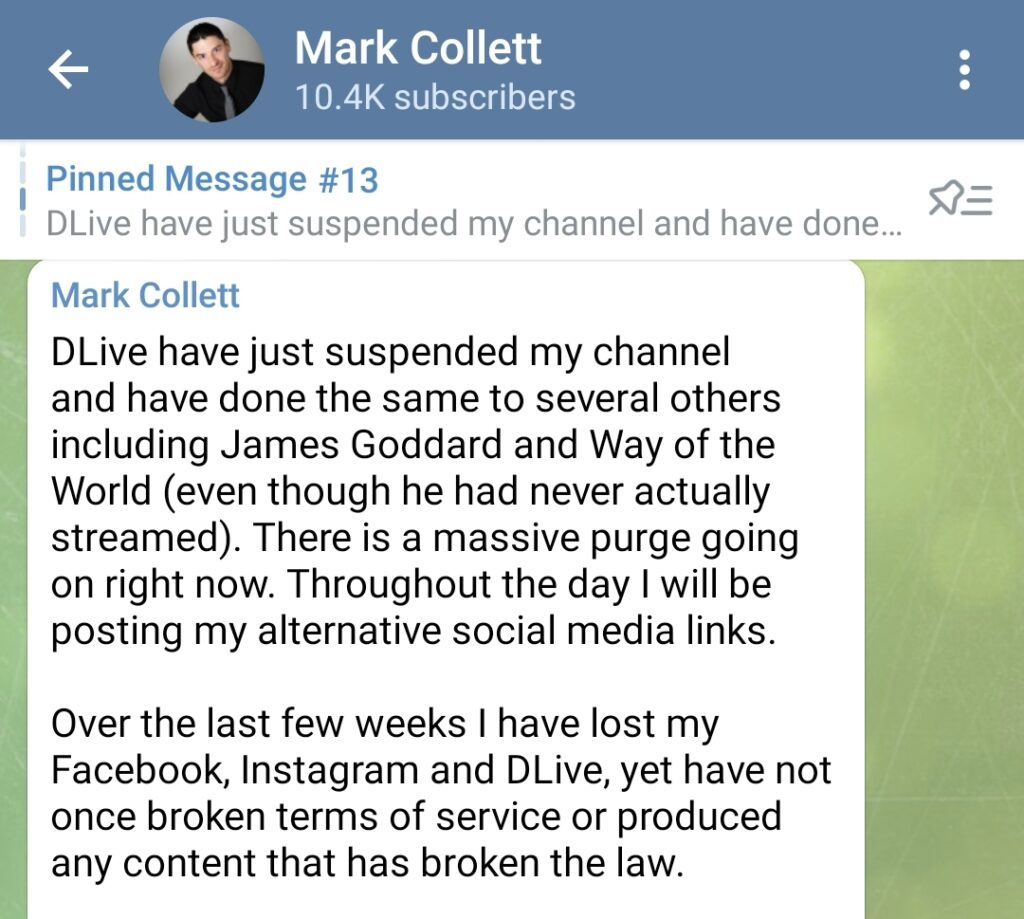
The far right then suffered another major set back when fash channel of choice Parler was first hacked, then banned from the Apple and Google stores and finally taken down completely for a period after the Capitol riots allegedly incited by then USA President Donald Trump. Parler is back up but users of the platform have lost faith in it from both a data protection and a free speech perspective. The fact that the CEO was fired also suggests Parler is moving away from the direction of uncensored hate speech.
So the initial platforms of choice for the far right have all been non starters. Telegram has minimal censorship but doesn’t have a decent reach. Gab.com has poor security, Parler, Bitchute and VK have all done a U turn on censorship, DLive won’t tolerate racism and hardly anybody has ever heard of Minds.
In desperation Robinson and Britain First even tried teen video site Tik Tok but they got banned from there too!
These high profile suspensions across platforms have been picked up by the press with the result that the public at large are now a lot more savvy about the dangers of far right extremists and their ilk.
What we are seeing now in early 2021 is a scrabbling for a platform, any platform that is willing to host the odious extremists who align themselves with the far right. This has led to the use of platforms so obscure practically nobody is aware of them. Britain First are using a video site called ‘Trovo’, Patriotic Alternative are on a site called ‘Odysee’ and Tommy Robinson is just hoping people will visit his website and give him money (Which given his admission in the press on 4 March when he said he has run out of money suggests that strategy isn’t working too well…).
The push back from social media and the resulting dispersal of the far right has led to a fragmented, bitterly divided and ineffectual movement. Racists and fascists have been marginalised and pushed into echo chambers on the fringe of society where they belong.
For far right extremists, 2021 signals the beginning of the end. For the decent people who make up the rest of society, 2021 is an opportunity to start looking toward a better world where hate is no longer tolerated.
Roanna Carleton Taylor is one of the founder members of Resisting Hate. She is the author of many of our articles, and also writes occasionally for other media publications including Huff Post, Byline Times and Immigration News. Roanna loves German Shepherd Dogs and Oil Painting.
[…] published an article this week discussing the difference between online far right social media in 2016 and 2021. It’s a positive read and shows just how far we have all come in clearing hate from the […]